Loblaw Companies Bundle
Can Loblaw Companies Maintain Its Dominance?
Loblaw Companies, a cornerstone of the Canadian retail industry, has a fascinating history. From its early days pioneering the self-serve grocery model to its current status as a retail giant, Loblaw's evolution reflects a commitment to innovation and strategic growth. Understanding its journey is key to grasping its future trajectory and potential for investors and business strategists alike.
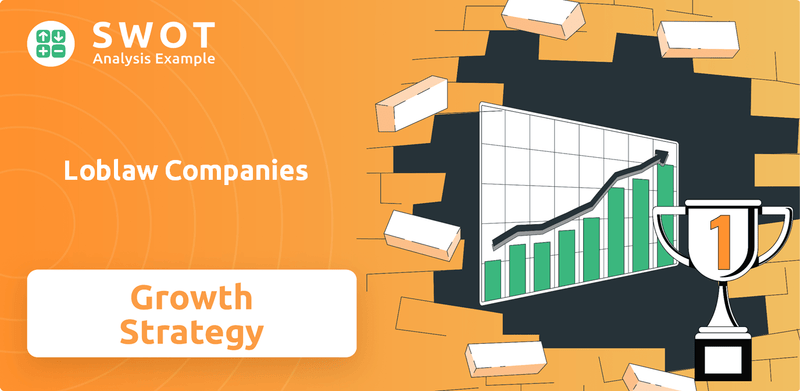
This analysis delves into the Loblaw Companies SWOT Analysis and its growth strategy, examining its expansion plans, financial performance, and competitive advantages within the dynamic retail industry. We'll explore Loblaw's market share analysis, digital transformation strategy, and sustainability initiatives, providing actionable insights for navigating the Canadian market. Furthermore, we'll examine Loblaw's future investment plans and their impact on the Canadian economy, offering a comprehensive business analysis.
How Is Loblaw Companies Expanding Its Reach?
Loblaw Companies Limited is actively pursuing an aggressive expansion strategy, particularly emphasizing its hard discount banners, to meet evolving consumer demands and expand its market reach. This strategy is a key component of its overall Growth Strategy within the Retail Industry.
In 2025, Loblaw plans to invest $2.2 billion into the Canadian economy. This reflects a clear strategy to attract price-sensitive customers amid ongoing economic pressures and inflation. This substantial investment includes opening approximately 80 new food and drug stores, with a significant focus on hard discount formats like No Frills and Maxi, aiming for around 50 new hard discount locations in 2025.
The company's strategic focus on expansion is designed to strengthen its position in the Canadian Market and enhance its Loblaw Future prospects. This is a crucial part of their Business Analysis.
Loblaw aims to open approximately 80 new food and drug stores in 2025. A significant portion of these openings will be hard discount stores, such as No Frills and Maxi. This expansion is a direct response to the increasing demand for value-oriented shopping options.
More than 300 grocery and pharmacy locations are slated for renovation in 2025. Additionally, Loblaw plans to add approximately 100 new Shoppers Drug Mart pharmacy care clinics. This expansion in healthcare services aligns with Loblaw's 'Connected Healthcare strategy'.
Loblaw opened its first T&T Supermarket in the United States in Q4 2024, indicating interest in international expansion. The company is also committed to supporting Canadian companies and brands, highlighting Canadian-made products in its stores.
Loblaw plans to invest over $10 billion by 2030. In Q1 2025, the company onboarded 30 new Canadian suppliers. This investment underscores Loblaw's commitment to growth and its positive impact on the Canadian economy.
Loblaw's expansion initiatives for 2025 include significant investments in new store openings, renovations, and healthcare services. These initiatives are designed to enhance Loblaw's market share and customer reach.
- Opening approximately 80 new food and drug stores
- Renovating over 300 grocery and pharmacy locations
- Adding around 100 new Shoppers Drug Mart pharmacy care clinics
- Investing $2.2 billion in the Canadian economy in 2025
Loblaw Companies SWOT Analysis
- Complete SWOT Breakdown
- Fully Customizable
- Editable in Excel & Word
- Professional Formatting
- Investor-Ready Format
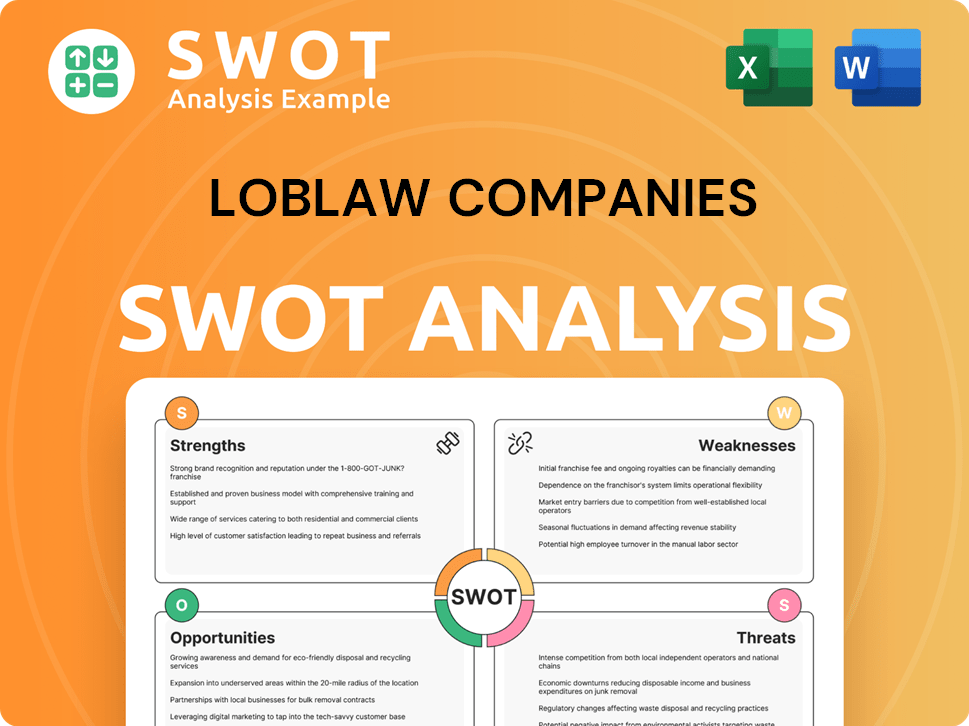
How Does Loblaw Companies Invest in Innovation?
The Loblaw Companies is actively investing in innovation and technology to drive its growth strategy and maintain a competitive edge within the retail industry. This approach is crucial for navigating the dynamic Canadian market and ensuring long-term success. The company's focus includes significant investments in digital platforms, supply chain modernization, and sustainability initiatives, all of which are designed to enhance customer experience and operational efficiency.
A key aspect of Loblaw's future involves leveraging technology to meet evolving customer needs and preferences. This includes expanding its e-commerce capabilities and optimizing its supply chain to ensure product availability and freshness. By focusing on these areas, the company aims to strengthen its position in the grocery retail sector and adapt to changing consumer behaviors.
Loblaw's strategic investments are also aimed at improving its operational efficiency and reducing its environmental impact. This includes the implementation of automated distribution centers and the adoption of sustainable practices throughout its operations. These initiatives are designed to enhance the company's competitive advantage and contribute to its overall business analysis.
Loblaw Digital, including PC Express™, is a key focus for digitally engaging customers and improving their experience. This area is critical for the company's e-commerce strategy and overall digital transformation strategy.
Significant capital investments are being made in modernizing and automating Loblaw's supply chain. This includes the development of large, automated distribution centers to improve efficiency and service.
Loblaw is committed to environmental sustainability and social impact, integrating these aspects into its business strategy. This includes reducing carbon emissions and minimizing food waste.
The PC Optimum™ program is a customer loyalty program designed to enhance customer engagement and drive sales. This program is a key component of Loblaw's customer-focused strategy.
Loblaw Advance™ is another area of focus, likely involving technological advancements and strategic initiatives to improve operational efficiency and customer experience.
Loblaw aims to achieve net-zero emissions for its operational footprint by 2040 and for scope 3 emissions by 2050, demonstrating a strong commitment to environmental stewardship.
Loblaw's innovation and technology strategy encompasses several key initiatives designed to drive growth and improve operational efficiency. These initiatives are crucial for maintaining Loblaw's market share analysis and adapting to the changing Canadian market.
- E-commerce Expansion: The company's e-commerce sales increased by 17.4% in the first quarter of 2025, highlighting the success of its digital platforms and e-commerce strategy.
- Automated Distribution Centers: In January 2025, Loblaw began migrating operations to a 1.2 million square foot, fully automated distribution center in Ontario. A similar facility is planned for Caledon, reflecting Loblaw's commitment to advanced supply chain management.
- Sustainability Programs: In 2024, the company reduced carbon emissions by 16% compared to a 2020 baseline. Loblaw is also working to reduce food waste and aims to send zero food to landfills by 2030, demonstrating its commitment to sustainability initiatives.
- Plastic Packaging Initiatives: Loblaw achieved over 90% compliance with the Golden Design Rules for plastic packaging for over 11,000 control brand items in 2024, with a goal of making all plastic packaging recyclable or reusable by 2025.
- Strategic Partnerships: Loblaw is part of the Canadian Alliance for Net Zero Agriculture, focusing on innovative technologies and regenerative agriculture practices to create a circular, net-zero agri-food chain, highlighting its strategic partnerships.
For a deeper understanding of the competitive landscape, consider reading about the Competitors Landscape of Loblaw Companies.
Loblaw Companies PESTLE Analysis
- Covers All 6 PESTLE Categories
- No Research Needed – Save Hours of Work
- Built by Experts, Trusted by Consultants
- Instant Download, Ready to Use
- 100% Editable, Fully Customizable
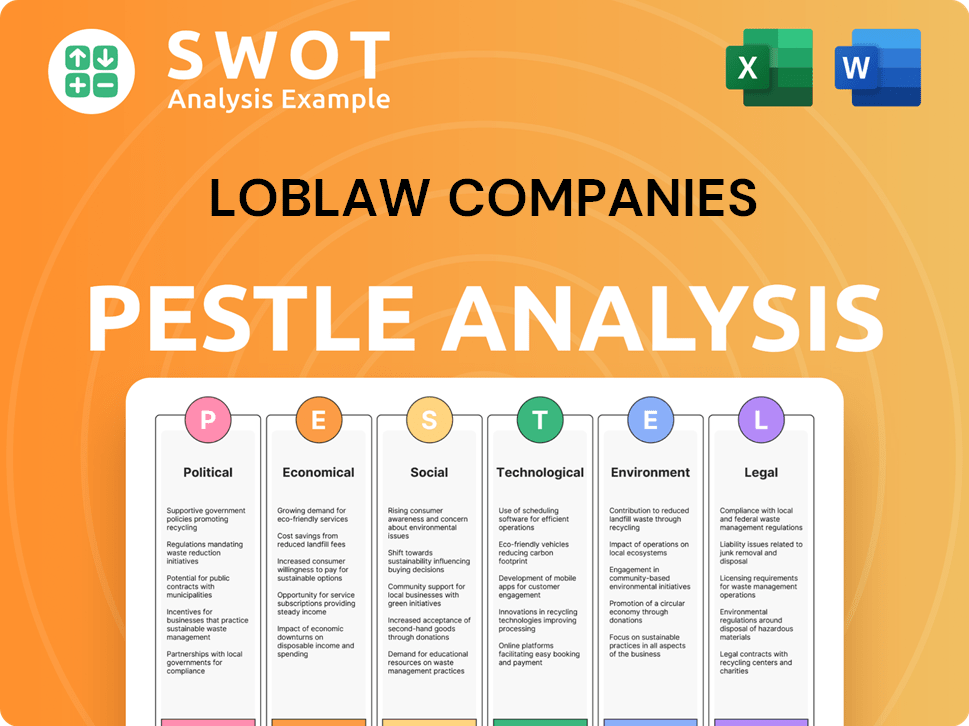
What Is Loblaw Companies’s Growth Forecast?
The financial outlook for Loblaw Companies Limited is positive, reflecting strong performance and promising growth prospects. For the fiscal year ending December 28, 2024, the company demonstrated robust financial health, with increases in both revenue and net earnings. This performance sets a solid foundation for future expansion and strategic initiatives within the Owners & Shareholders of Loblaw Companies.
Loblaw's strategic focus on enhancing its retail business is evident in its financial projections for 2025. The company anticipates that its retail operations will drive earnings growth at a rate exceeding sales growth. Furthermore, investments in capital projects, including new store openings, renovations, and supply chain modernization, are planned to support long-term growth and maintain its competitive edge in the Canadian market.
In fiscal year 2024, Loblaw reported a revenue of $61,014 million, marking a 2.5% increase. Net earnings available to common shareholders reached $2,155 million, reflecting a 3.2% rise. Adjusted diluted net earnings per common share grew by 10.3%, showcasing the company's profitability and operational efficiency.
The first quarter of 2025 saw Loblaw achieving a revenue of $14.1 billion, a 4.1% year-over-year increase. Adjusted diluted earnings per share for Q1 2025 grew by 9.3% to $1.88. The company also announced a 10% increase in dividends and repurchased $457 million in shares in Q1 2025.
Morningstar DBRS forecasts Loblaw's consolidated revenue to increase to approximately $64.5 billion in fiscal year 2025 and toward $66.0 billion in fiscal year 2026. This growth is expected to be driven by low-single digit food retail same-store sales growth in 2025, supported by modest food inflation and stable volumes.
Loblaw plans to invest $2.2 billion in capital projects in 2025. These investments will focus on new store openings, renovations, and supply chain modernization. Similar levels of investment are anticipated over the next five years, with over $10 billion planned by 2030, demonstrating a commitment to long-term growth.
Loblaw's growth strategy is supported by several key drivers, including strategic investments, expansion of its retail footprint, and operational efficiencies. The company's focus on digital transformation and customer loyalty programs further enhances its competitive advantage in the Canadian Market.
- Retail Expansion: New store openings and renovations.
- Supply Chain Modernization: Improving efficiency and reducing costs.
- Digital Initiatives: Enhancing e-commerce and customer experience.
- Strategic Partnerships: Collaborations to drive growth.
Loblaw Companies Business Model Canvas
- Complete 9-Block Business Model Canvas
- Effortlessly Communicate Your Business Strategy
- Investor-Ready BMC Format
- 100% Editable and Customizable
- Clear and Structured Layout
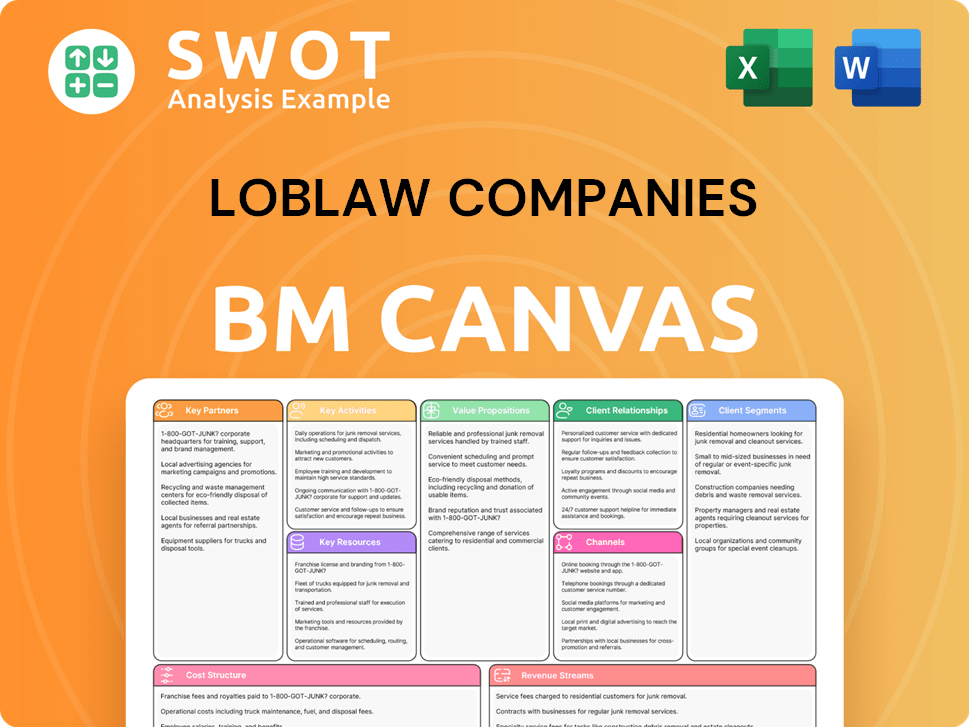
What Risks Could Slow Loblaw Companies’s Growth?
The path toward growth for Loblaw Companies is not without its hurdles. The company faces several potential risks and obstacles that could impact its financial performance and strategic objectives. These challenges range from market competition to the complexities of supply chain management and the need for continuous technological adaptation.
Competition within the Retail Industry, particularly in the grocery sector, poses a significant threat. Economic factors, such as inflation, also play a crucial role, influencing consumer spending and the company's profitability. For instance, a non-cash charge of $129 million related to the PC Optimum loyalty program in Q4 2024 reflects consumer behaviors in response to economic pressures.
Furthermore, supply chain vulnerabilities and technological disruptions are key areas of concern. Loblaw must navigate these challenges to maintain its competitive edge and ensure a seamless customer experience. The company’s ability to adapt to regulatory changes, especially within its pharmacy operations, is also critical for its future success. For more information about how Loblaw Companies operates, you can read more about the Target Market of Loblaw Companies.
Loblaw operates in a highly competitive Canadian Market. Competitors, including other discount retailers, constantly vie for market share. This competition can affect pricing strategies and profit margins, requiring Loblaw to continually innovate and offer value to maintain its competitive advantage.
Economic fluctuations, such as inflation, can significantly impact consumer spending. Rising costs can affect the purchasing power of consumers, potentially leading to changes in their shopping habits. For example, the Q4 2024 non-cash charge of $129 million related to the PC Optimum loyalty program highlights the impact of consumers seeking value amidst inflation.
Disruptions in the supply chain can lead to inventory issues and increased costs. Loblaw has developed strategies, such as a multi-vendor sourcing approach, to mitigate these risks. However, unexpected events, such as geopolitical instability or natural disasters, can still create significant challenges for their supply chain management.
The rapid pace of technological change requires continuous investment in e-commerce and digital solutions. Customers expect a seamless digital experience. If Loblaw's systems are damaged or fail, it could require significant capital investment. The e-commerce strategy is a key component of their growth plan.
Changes in regulations, particularly within the pharmaceutical sector, can affect Loblaw's pharmacy operations. Adapting to these changes requires careful planning and strategic adjustments. The company must continuously monitor and respond to evolving regulatory landscapes to maintain compliance and operational efficiency.
Loblaw's financial performance is subject to these risks. The company's ability to navigate these challenges will determine its growth trajectory. The 2024 Annual Information Form (AIF) provides detailed insights into these risks and uncertainties, which are critical for assessing Loblaw's future investment plans.
Loblaw Companies Porter's Five Forces Analysis
- Covers All 5 Competitive Forces in Detail
- Structured for Consultants, Students, and Founders
- 100% Editable in Microsoft Word & Excel
- Instant Digital Download – Use Immediately
- Compatible with Mac & PC – Fully Unlocked
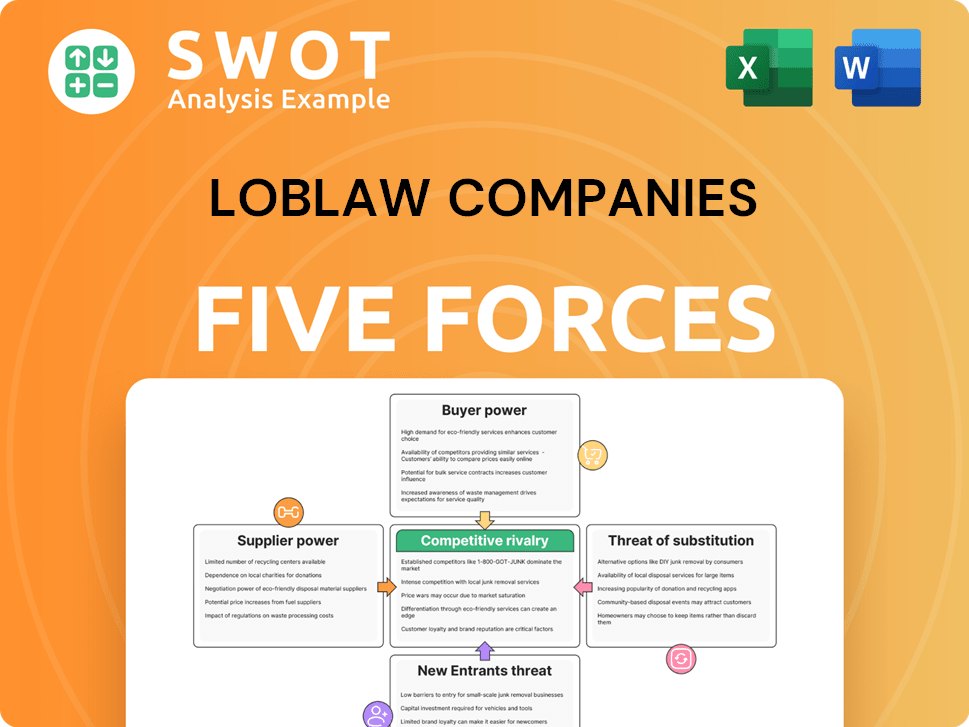
Related Blogs
- What are Mission Vision & Core Values of Loblaw Companies Company?
- What is Competitive Landscape of Loblaw Companies Company?
- How Does Loblaw Companies Company Work?
- What is Sales and Marketing Strategy of Loblaw Companies Company?
- What is Brief History of Loblaw Companies Company?
- Who Owns Loblaw Companies Company?
- What is Customer Demographics and Target Market of Loblaw Companies Company?
Disclaimer
All information, articles, and product details provided on this website are for general informational and educational purposes only. We do not claim any ownership over, nor do we intend to infringe upon, any trademarks, copyrights, logos, brand names, or other intellectual property mentioned or depicted on this site. Such intellectual property remains the property of its respective owners, and any references here are made solely for identification or informational purposes, without implying any affiliation, endorsement, or partnership.
We make no representations or warranties, express or implied, regarding the accuracy, completeness, or suitability of any content or products presented. Nothing on this website should be construed as legal, tax, investment, financial, medical, or other professional advice. In addition, no part of this site—including articles or product references—constitutes a solicitation, recommendation, endorsement, advertisement, or offer to buy or sell any securities, franchises, or other financial instruments, particularly in jurisdictions where such activity would be unlawful.
All content is of a general nature and may not address the specific circumstances of any individual or entity. It is not a substitute for professional advice or services. Any actions you take based on the information provided here are strictly at your own risk. You accept full responsibility for any decisions or outcomes arising from your use of this website and agree to release us from any liability in connection with your use of, or reliance upon, the content or products found herein.